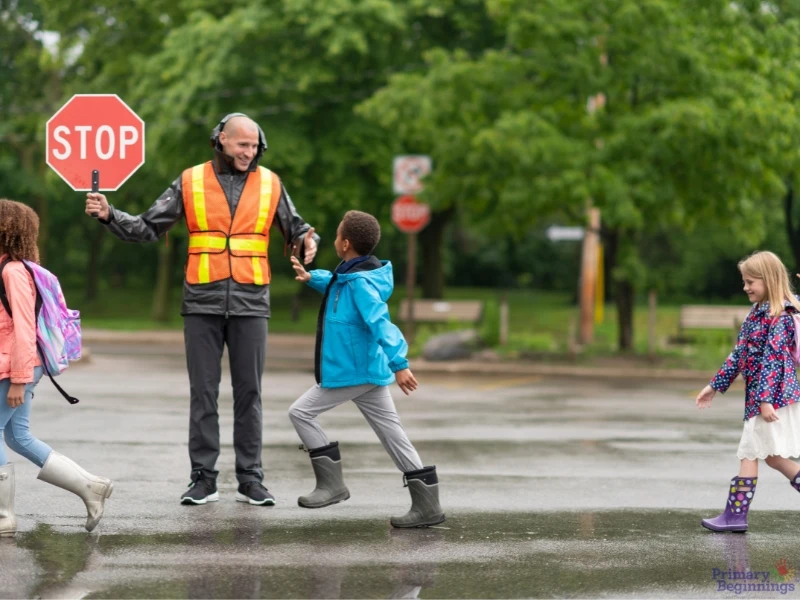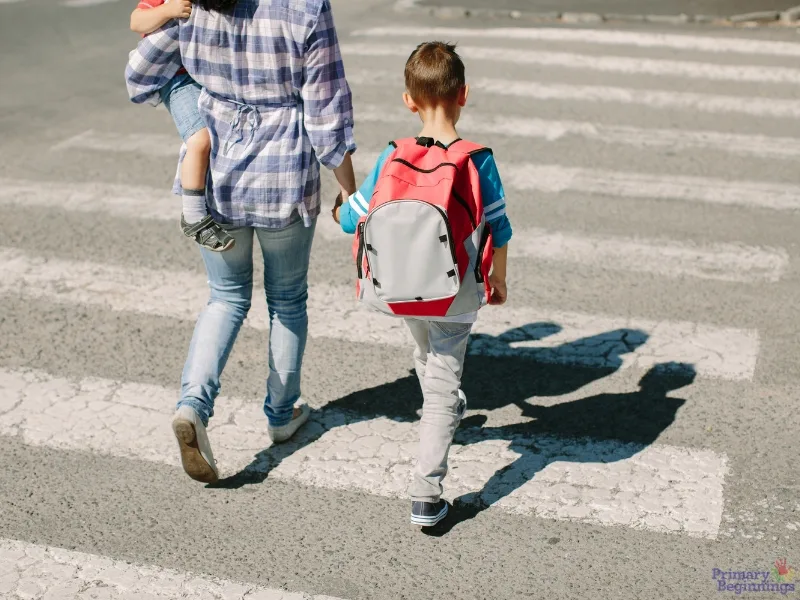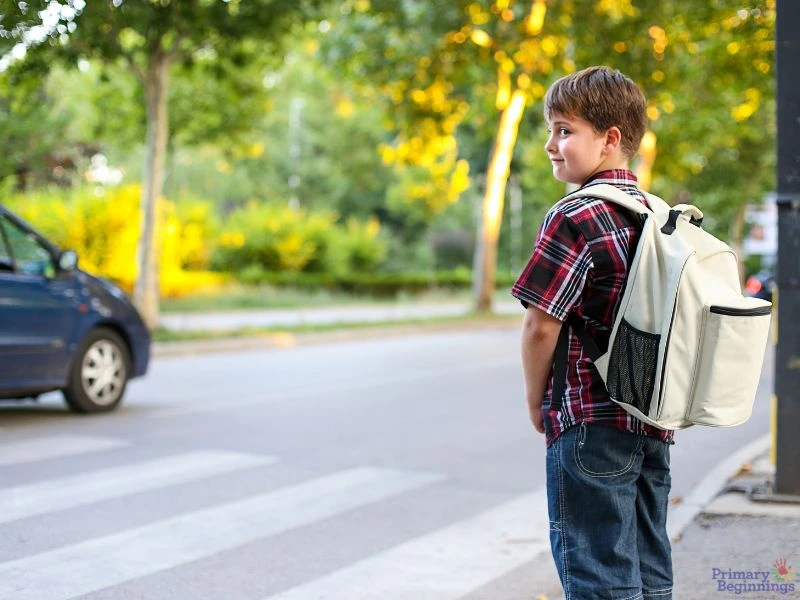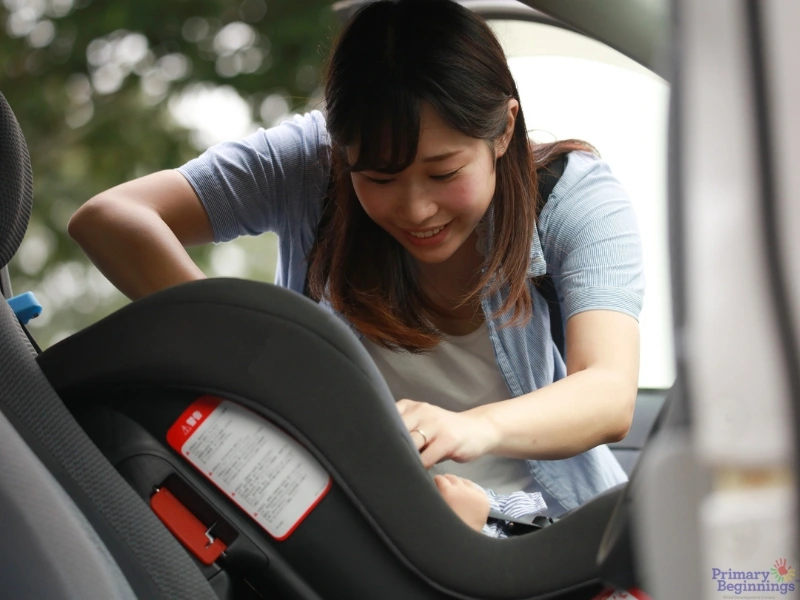Now that swimming season is upon us, we should refresh our knowledge on pool and…
Raleigh’s growing neighborhoods mean more cars, busier intersections, and longer school car lines. Teaching road safety for kids is vitally important so children learn how to move confidently and safely as pedestrians, passengers, and young riders.
Join our 5-star Raleigh preschool team at Primary Beginnings as we share practical, age-appropriate tips, road safety activities for preschoolers, and family routines that keep kids safe at drop-off, pick-up, and everywhere in between.
Table of Contents
Important Facts About Child Road Safety
Road safety saves lives. Even low-speed crashes can leave children injured, and traffic crashes remain a leading cause of serious injury and death for young people. Clear routines, steady supervision, and predictable pedestrian behavior reduce the chance of being killed or badly hurt—and help drivers respond in time.
As jarring as these road safety facts can be, it’s important for parents, teachers, and caregivers to recognize just how real the threats are when it comes to childhood street safety statistics:

- Vehicle-related incidents are a leading cause of child fatalities in the US.
- Traffic deaths are at epidemic levels, killing over 1.2 million people each year.
- Children are among the most vulnerable road users, with over 500 killed daily.
- According to the Centers for Disease Control and Prevention, crash injuries are the leading cause of death for people aged 5 to 29.
The Core Crossing Routine
Teach children a short routine they can repeat any time they approach a road:
- Stop: Stop at the edge when approaching a road, with their feet together at the curb or driveway edge.
- Look: Look left–right–left again to scan for vehicles, bikes, and turning drivers.
- Listen: Listen for engines, horns, and movement, as many vehicles are quiet—kids should listen more than once.
- Think: Think and make eye contact, then wait until drivers stop and you see their presence and wheels fully still.
- Walk, Don't Run: Cross briskly, but don’t run. Keep walking in a straight path, and never dart between parked cars.
Key Signals and Signs to Practice
- Walk/Don’t Walk: Cross only on “walk,” then re-check for turning cars.
- Stop Sign and Red Light: Everyone stops; pedestrians still look both ways.
- Yield and One-Way: Teach children that drivers might turn unexpectedly—keep scanning.
- School Zone and Bus Stop: Slow areas with many children and buses deserve extra attention.
How to Cross the Road Safely at Signals
- Wait on the curb, not in the street.
- Start on “walk,” then keep looking and listening.
- Hold hands with young children.
- Finish crossing even if the signal changes while you’re in the crosswalk.
- If a path is blocked, stop and choose a safer route.

School Road Safety Rules for Kids
School routines are where most daily practice happens, so set these expectations early:
- Use crosswalks and crossing guards: Follow directions from adults; they’re there to manage traffic and pedestrians.
- Walk on sidewalks and along painted paths: If a sidewalk is blocked, walk single file facing traffic.
- Follow car-line rules: Exit on the curb side, not into traffic.
- Wait for the bus safely: Stand back from the curb, never chase a bus, and only cross in front of it when signaled by the driver.
- Hands held for young children: Adult supervision reduces risk at busy school entrances and intersections.
The Hidden Risks of Driveways, Parking Lots, and Intersections

Many injuries happen off the main road. Teach children to treat parking lots and driveways like roads with these rules:
- Slow down at intersections: Even with a walk sign, scan for turning vehicles.
- Never walk behind reversing vehicles: Drivers can’t always see small pedestrians.
- Pause at every aisle: Look and listen before crossing.
- Hold hands near moving cars: Adult assistance keeps little ones from darting.
Bike and Scooter Road Safety for Kids
Wheels are exciting—and they require steady practice to prevent injury. Keep rides short at first, and pick calm spaces away from heavy traffic.
Helmet Fit and Gear
- Helmet every ride: Centered, level, and snug with a V under each ear.
- Closed-toe shoes and simple clothing: Avoid strings that can catch on a vehicle, wheel, or handlebar.
- Lights/reflectors for dusk: Help drivers and other riders see children sooner.
Riding Paths and Intersections
- Choose parks, cul-de-sacs, or greenways: Fewer vehicles mean fewer risks while children build skills.
- Slow at every driveway: Treat each driveway like a mini-intersection.
- Walk bikes across busy intersections: It’s easier to look, listen, and react while walking.
Car and Booster Seat Basics for Passenger Safety
Children are safest when they ride in the right seat for their size and stay buckled on every trip. When you have a child in your vehicle, remember:
- Curb-side entry and exit only: Use the door closest to the sidewalk to reduce exposure to traffic.
- Right seat, right fit: Follow manufacturer guidance for rear-facing, forward-facing, and boosters.
- Model good habits: Adults buckle first every time.
- Stay seated, stay buckled: No leaning out of windows, unlocking doors, or unbuckling until the vehicle stops.

Pedestrian Safety Precautions for Children in Raleigh
Raleigh families enjoy greenways, parks, and busy downtown streets. Pedestrian safety is about being visible, aware of surroundings, and predictable while walking near traffic.
Hand-in-Hand and Eyes Up
For toddlers and preschoolers, adult supervision is non-negotiable in any traffic environment. Hold hands near roads, guide children to stop at every curb, and narrate what you see so they learn to identify risk and read the road.
Be Seen with Bright Clothing and Clear Signals
Teach children to wear bright or reflective accents when walking near traffic at dawn/dusk. Practice clear body language—standing tall at the curb, facing traffic, and making eye contact with drivers—so pedestrians are easier to spot.
Sidewalks, Paths, and Greenways
Favor sidewalks and multi-use paths when possible. If there’s no sidewalk, walk facing traffic in a single file line. On Raleigh’s greenways, teach children to keep right, listen for bikes, and say “passing on your left” when they overtake others.
Road Safety Activities for Toddlers
Hands-on play makes safety lessons stick. These road safety activities for preschoolers and toddlers build attention, listening, and decision-making skills through play-based learning.
Red Light/Green Light
A classic movement game that builds impulse control and helps kids practice stopping before a crossing or driveway—key for pedestrian safety near traffic and cars.
How to play: One adult or child is the “signal.” Call “Green light” (children walk) and “Red light” (everyone stops and freezes). Add “Yellow light” to slow down and “Walk sign” to cross an imaginary road.
Activity type: Group or partner.
What it teaches: Listening skills, quick stopping, following signals, awareness of surroundings, and the idea that pedestrians move only when it’s safe.
Sidewalk Chalk Streets
Create a child-sized “road” to safely practice road safety rules for kids without real vehicles around.
How to play: Draw lanes, crosswalks, stop lines, arrows, and a “bus stop.” Children walk along the path, stop at crosswalks, and wait for a pretend “walk” signal. Rotate roles as walkers, “drivers,” and crossing guards.
Activity type: Individual or small group.
What it teaches: Identifying signs and path markings, stopping at edges, scanning for oncoming traffic, and predictable walking.
Sound Hunt
Helps kids practice listening for vehicles they can’t see—an essential part of crossing safely.
How to play: In a safe area, have children close their eyes (or look down) while an adult names “listen targets” (engine idling, horn, bicycle bell, footsteps). Kids raise a hand when they hear a sound, then point to where it came from.
Activity type: Individual or group.
What it teaches: Focused listening, locating sounds, noticing the presence of traffic, and pausing to hear before stepping into the road.
Push-Car Parking
A playful way to show how driveways and parked cars can hide pedestrians from drivers.
How to play: Set up taped “driveways” and “parking spots.” Children push toy cars slowly in and out while others pretend to walk on the sidewalk, stopping at each driveway edge before “crossing.”
Activity type: Partner or small group with adult supervision.
What it teaches: Blind spots, slowing at driveways, eye contact with drivers, and waiting for vehicles to stop before crossing.
Sign Scavenger Hunt
Turns neighborhood walks into lessons about traffic signs and pedestrian signals.
How to play: Carry a simple checklist (stop sign, walk symbol, one-way arrow, school zone). On a short walk, kids spot each item and say what it means for pedestrians and vehicles.
Activity type: Individual or family group.
What it teaches: Sign recognition, matching symbols to actions (stop, wait, cross), and reading the environment to move safely.
Crossing Guard Role-Play
Practices waiting, signaling, and orderly crossing like at school.
How to play: Set cones for a “crosswalk.” One child (or adult) is the crossing guard with a paddle or hand signal; others are pedestrians. The guard scans left–right–left, raises the stop signal, and invites walkers to cross when “traffic” is stopped.
Activity type: Group or partner.
What it teaches: Adult assistance roles, scanning for risk, clear communication with drivers, and crossing in a straight path.
Driveway Drill
Shows why every driveway is treated like a small intersection.
How to play: Tape a short “sidewalk” with a driveway opening. Children walk the path and must stop at the driveway edge, look left–right–left, listen, and only cross when the “driver” (another child or adult with a toy car) waves them on.
Activity type: Partner or small group.
What it teaches: Edge detection, pausing at driveways, checking for oncoming traffic, and not walking behind reversing vehicles.
Map Our Walk
Helps children plan a safe route and remember school road safety rules.
How to play: Sketch a simple map from home to a familiar place (school, park). Mark sidewalks, crosswalks, and safe meeting spots. Walk the route and compare the plan to real signs and signals.
Activity type: Individual with parent or small group.
What it teaches: Route planning, identifying safer crossings, practicing decision-making, and turning lessons into everyday habits for road safety for kids.
Teaching Children Road Safety Through Everyday Routines
Learning to road safely is a daily practice. Short, consistent lessons—layered with gentle reminders—build habits that prevent injury and keep kids safe. When engaging in outdoor activities with kids, it's always valuable to review these lessons.
Micro-Lessons on Every Walk
- Narrate what you see: “I hear a car; let’s pause.”
- Point out signs: “That red octagon means stop for pedestrians.”
- Model patience: Children learn from calm adults who wait for safe gaps in traffic.
Family Agreements That Stick
- Hands held near roads until ready: Decide together when children can cross with verbal cues instead of holding hands.
- No running into the street: Balls and toys stop at the curb—adults retrieve them.
- Ask for assistance: Children call for an adult when a crossing feels confusing.
Preschool Road Safety Worksheet Ideas

A preschool road safety worksheet can reinforce classroom lessons and help families practice at home.
Try:
- Match the Signal: Draw a line from the walk symbol to a picture of pedestrians crossing.
- Safe vs. Unsafe Sorting: Cut-and-paste pictures of walking on sidewalks vs. between parked cars.
- Dot-to-Dot Signs: Connect dots to make a stop sign or crosswalk symbol.
- Sequence the Steps: Arrange cards for stop–look–listen–think–cross.
Road Safety for Kids FAQs
What age can kids cross a road alone?
Readiness varies. Many children need an adult until around age 10 because judging speed, distance, and oncoming traffic takes time to develop. Start with supervised practice and gradually release responsibility.
What if the sidewalk is blocked?
Stop and choose a safer path. Walk facing traffic in single file and keep extra distance from vehicles. Re-enter the sidewalk as soon as it’s clear.
How do I keep kids visible at dusk or dawn?
Pick bright clothing, add a reflective sticker or band, and carry a small light. Make eye contact with drivers before crossing and continue to listen while walking.
Which signs should my preschooler learn first?
Start with stop signs, walk/don’t walk signals, and one-way arrows. These give clear, actionable guidance to pedestrians and help children identify safe places to cross.
How often should we practice toddler road safety?
Short lessons a few times a week work best—think 2–5 minute refreshers on the way to school, at the park, or during evening walks.
What if my child is nervous about traffic?
Normalize the feeling, then practice in quiet areas first. Build up gradually to busier places, praising careful choices and calm walking.
Learn Essential Life Lessons at Our 5-Star Raleigh Preschool
Keeping children safe around roads takes patient teaching, steady practice, and supportive adults. Primary Beginnings partners with families to teach children predictable routines, strong listening skills, and the confidence to navigate roads and school spaces more safely. Learn more about our early childhood programs by contacting our team today.
Call us at 919-790-6888 or fill out the form below to request a tour of one of our three Raleigh preschool locations and see our safety-first classrooms in action.
